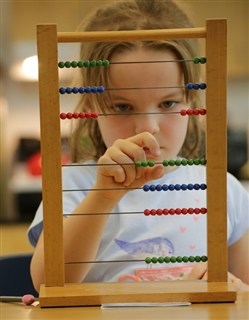News
News
Supporting Your Child in His Stretch Zone: The True Learning Zone

Imagine a three-ring archery target - a large circle with two concentric circles inside framing the bullseye. Now imagine the small area in the center is your child's comfort zone. In that zone, he feels at ease, stress-free and secure. When he is in the comfort zone in the classroom, he chooses work he knows well and has likely already mastered.
He may work with a very familiar material, but may not be completely engaged in the process or may use it as a way to recharge after acquiring a new skill. The work tends to look mechanical; skill building is rarely the goal of the comfort zone. It is important to note that it is called the comfort zone because it is a place of security, and every child has a need to return to this zone to regain equilibrium. Knowing your child well helps you know just how big your child's comfort zone is. Every child has a different comfort zone which changes as he experiences growth in other zones.
Conversely, the outermost circle of the target is the stress, or panic zone. When a child has an experience that pushes him out to the panic zone, he faces extreme anxiety and discouragement. He cannot make progress because he is too far outside his comfort zone. Learning cannot take place in a state of stress, and being in this zone leaves the child with a diminished sense of self, making him more hesitant to take risks in the future.
Happily, there is an area in between comfort and panic, where the child learns with just the right amount of effort and challenge. This middle ring is the optimal place for growth and is called the stretch or learning zone. Here the task is just out of reach of the child's current skill and ability. A child in the learning zone experiences engagement and joyfulness, and performance and creativity reach their peak when a child works at this level. The stretch zone is also where a child develops resilience and deepens his coping skills. In order for a child to have this opportunity, parents must develop a tolerance for watching their child experience some challenge or difficulty. Likewise, teachers must recognize the value of the stretch zone and the recharging done in the comfort zone and offer protections from the stress zone.
Our Montessori curriculum recognizes that children learn best through hands-on activities that build on previously mastered skills. Every lesson begins with a review of these skills and adds just enough challenge to further intellectual advancement. Dr. Montessori’s theories of learning were supported by the work of her contemporary Dr. Lev Vygotsky who also believed that children take an active, not passive, role in their own learning. Both believed that ideal learning happens when a child is given a task and receives support from a knowledgeable guide. Vygotsky called it the zone of proximal development. Growth in this zone comes faster because the child takes on just the right amount of risk and is given direction, support and encouragement to work through roadblocks. When the child feels success, appropriate intellectual risk-taking becomes easier and helps the child remain open to new experiences that lead to more intellectual progress.
Contemporary thinking, such as Flow Theory by psychologist Dr. Mihaly Csikszentmihalyi, also supports Montessori’s work. Csikszentmihalyi purports that people are happiest when they are in a state of flow, defined as being absorbed in a task where skill, interest and enjoyment are perfectly matched. In this state, hunger, fatigue and the passage of time become irrelevant as one’s absorption in the task is so great. We strive for flow in our classrooms.
In order for real growth to occur, there must be risk – not comfort or panic, but appropriate challenge that propels learning forward. Possibly scary at first, development of a “friendliness with failure” is key. This is how children learn to walk, to read, to get the big role in the school play and to land their first jobs. It is also how they develop their resilience to disappointments and setbacks along with the determination to try again.
Children need to see the adults around them take risks, too. When you try a new food, play a new game or tackle a new skill, make a point to talk to your child about it. What made you decide to do it? Were you successful? How did you feel beforehand and afterward? When parents are open to new experiences, children feel more comfortable stepping out of their comfort zones, too.


today
1 day ago